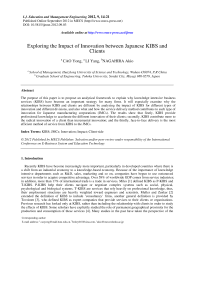Exploring the Impact of Innovation between japanese KIBS and Clients
Автор: CAO Yong, LI Yang, NAGAHIRA Akio
Журнал: International Journal of Education and Management Engineering(IJEME) @ijeme
Статья в выпуске: 9 vol.2, 2012 года.
Бесплатный доступ
The purpose of this paper is to propose an analytical framework to explain why knowledge intensive business services (KIBS) have become an important strategy for many firms. It will especially examine why the relationships between KIBS and clients are different by analyzing the impact of KIBS for different types of innovation and different divisions, and also what and how the service delivery method contributes to each type of innovation for Japanese manufacturing corporations (JMCs). The results show that firstly, KIBS provide professional knowledge to accelerate the different innovation of their clients; secondly, KIBS contribute more to the radical innovation of a client than incremental innovation; and the thirdly, face-to-face delivery is the most efficient method of service from KIBS to the JMCs.
KIBS, JMCs, Innovation, Impact, Client-side
Короткий адрес: https://sciup.org/15013746
IDR: 15013746
Список литературы Exploring the Impact of Innovation between japanese KIBS and Clients
- I. Miles. (1995) ‘Knowledge-intensive business services-users, carriers and sources of innovation’, A report to DG13 SPRINT-EIMS, pp.27-28.
- E. Muller and A. Zenker. (2001) ‘Business services as actors of knowledge transformation: the role of KIBS in regional and national innovation systems’, Research Policy, Vol.30, No.9, pp. 1501-1516.
- M. Tovoinen. (2006) ‘Future Prospects of Knowledge-Intensive Business Services (KIBS) and Implications to Regional Economies’ , The ICFAI Journal of Knowledge Management, Vol. 4, No. 3, pp. 18-39.
- A Torre and A Rallet. (2005) ‘Proximity and localization’, Regional Studies, Vol.39, No.1, pp.47-59.
- Lee KR. (2004) ‘Utilization of knowledge intensive services for the innovation of manufacturers in Korea’, Journal of Technology Innovation, Vol.12, No.2, pp.263-267.
- Wei Jiang. (2006) ‘pattern of innovation in KIBS’, Science Research Management (in Chinese)”, Vol.27, No.1, pp.70-75.
- Wood. P. (2006) ‘The regional significance of knowledge-intensive services in Europe’, Innovation: The European Journal of Social Sciences, Vol.19, No1, pp. 51-66.
- Garcia, R. and Calantone, R. (2002). “A critical look at technological innovation typology and innovativeness terminology: a literature review”, Journal of Product Innovation Management, Vol. 19 No 2, pp.110–132
- Kleinschmidt, E.J. and Cooper, R.G. (1991). “The impact of product innovativeness on performance”, Journal of Product Innovation Management, Vol. 8 No 4, pp. 240–251
- Vanchan, V. (2007). “Communication and relationships between industrial design companies and their customers”, The Industrial Geographer, Vol. 4 No 2, pp. 28-46
- Mccole, P. and Ramsey, E. (2004). “Internet-enabled technology in knowledge-intensive business services: a comparison of Northern Ireland, the Republic of Ireland and New Zealand”, Marketing intelligence & planning, Vol. 22 No 7, pp. 761-779
- Simmie, J. and Strambach, S. (2006). “The contribution of KIBS to innovation in cities: an evolutionary and institutional perspective”, Journal of knowledge management, Vol. 10 No 5, pp. 26-40


